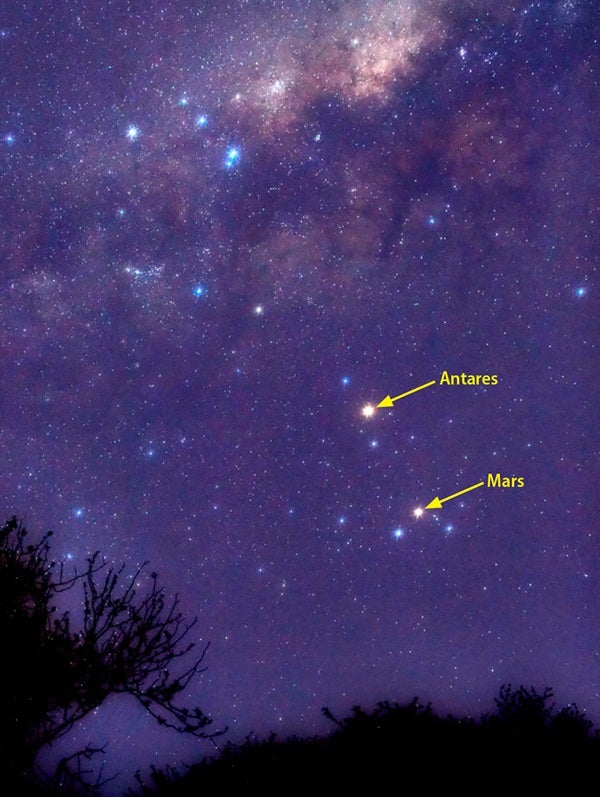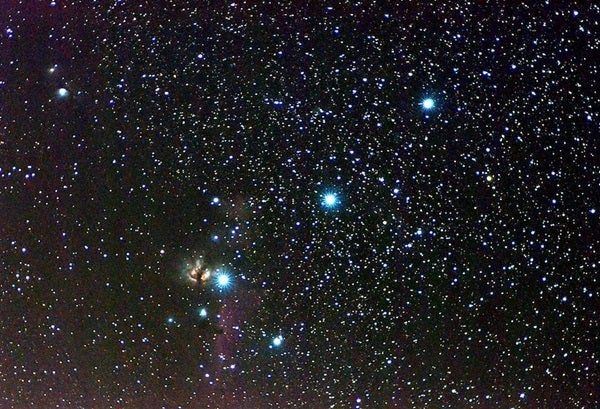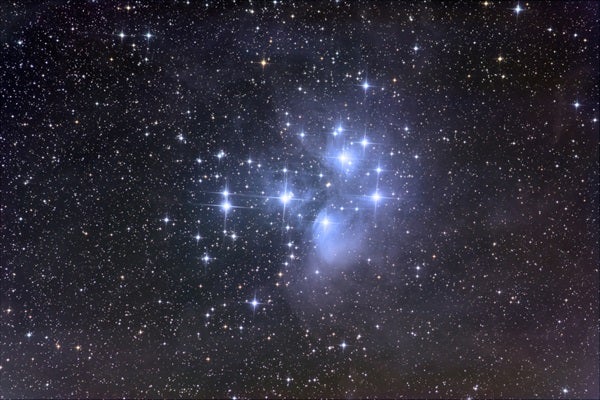The variable star Algol in Perseus reaches minimum brightness at 9:45 p.m. EST, when it shines at magnitude 3.4. If you start watching it during the midevening hours, you can see it more than triple in brightness (to magnitude 2.1) over the course of about five hours. This eclipsing binary star runs through a cycle from minimum to maximum and back every 2.87 days. Algol appears nearly overhead after darkness falls and dips toward the northwestern horizon well after midnight.
Saturday, January 13
Look low in the southeast before dawn to find two bright planets standing next to each other. Mercury appears brighter, shining at magnitude –0.3, while Saturn glows at magnitude 0.5. Both lie 7° above the horizon a half-hour before sunrise, with Saturn 0.6° (about the diameter of a Full Moon) north of the inner planet. Binoculars will afford the best view of this pretty conjunction.
Sunday, January 14
A slender crescent Moon hangs above Saturn and Mercury this morning. Luna appears 6 percent lit and stands 7° from Saturn, which, in turn, lies 1.7° above Mercury.
The Moon reaches apogee, the farthest point in its orbit around Earth, at 9:10 p.m. EST. It then lies 252,565 miles (406,464 kilometers) from Earth’s center.
Monday, January 15
A 2-percent-lit crescent Moon lies directly to the left of Mercury in this morning’s sky. The two stand 3° apart and some 6° above the southeastern horizon 30 minutes before sunrise. Meanwhile, Saturn lies just 3° to Mercury’s upper right. The trio looks best through binoculars.
One of the sky’s most familiar constellations rules January’s sky from dusk until near dawn. Orion the Hunter appears conspicuous in the southeast after darkness falls and climbs highest in the south around 10 p.m. local time. It then stands about halfway to the zenith from mid-northern latitudes. The night sky’s brightest star, Sirius, trails about an hour behind Orion.
New Moon occurs at 9:17 p.m. EST. At its New phase, the Moon crosses the sky with the Sun and so remains hidden in our star’s glare.
Wednesday, January 17
Mars stands out in the southeastern sky before dawn this week. The magnitude 1.3 Red Planet rises shortly before 3 a.m. local time and appears 25° high as twilight starts to paint the sky. It currently resides among the background stars of Libra, approximately 5° east of brilliant Jupiter. Unfortunately, the view of Mars through a telescope proves disappointing — it spans only 5″ and shows no detail.
Thursday, January 18
Although the Moon reached its New phase just two days ago, its rapid orbital motion carries it into view after the Sun goes down this evening. Look low in the west-southwest about an hour after sunset and you’ll see its 3-percent-lit crescent hanging in the twilight like the smile of the Cheshire Cat.
Friday, January 19
Uranus reached opposition and peak visibility three months ago today, but it remains a tempting target. The outer planet appears nearly two-thirds of the way to the zenith in the southern sky as darkness falls. The magnitude 5.8 world lies in southeastern Pisces, 3.5° west of the 4th-magnitude star Omicron (ο) Piscium. Although Uranus shines brightly enough to glimpse with the naked eye under a dark sky, binoculars make the task much easier. A telescope reveals the planet’s blue-green disk, which spans 3.5″.
Two of the finest deep-sky objects shine prominently on January evenings. The Pleiades and Hyades star clusters appear highest in the south in early evening but remain conspicuous until well past midnight. The Pleiades, also known at the Seven Sisters and M45, looks like a small dipper to the naked eye. The larger Hyades forms the V-shaped head of Taurus the Bull. Although both look nice without optical aid, binoculars show them best.
Sunday, January 21
Head outside before dawn and you’ll find Jupiter blazing in the southeast some 7° to the upper right of Mars. The giant planet climbs 30° high by the time twilight commences. Jupiter shines at magnitude –1.9, which makes it the brightest point of light in the night sky, and resides among the much dimmer stars of the constellation Libra. A telescope reveals the planet’s 35″-diameter disk.












